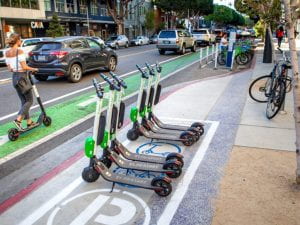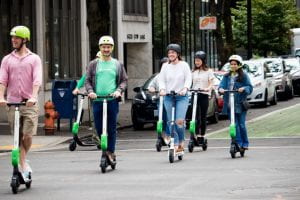By Karen Mason, Graduate in Community and Regional Planning from the University of Oregon
The popularity and rate of adoption of this new mode has been remarkable. The first electric shared-use scooters (e-scooters) appeared on the streets of Santa Monica, CA in September of 2017. By May 2019, fourteen electric scooter companies were operating across 97 American cities. As with anything new, however, there are challenges to be addressed. One such challenge is answering the question, “How should cities regulate e-scooters as they become a more common piece of the urban landscape?” As part of my Community and Regional Planning graduate studies at the University of Oregon, I set out to answer this question.

Why do scooters need to be regulated? A preliminary internet search will quickly reveal some of the challenges facing cities with e-scooter programs as an abundance of new articles and photos of “scooters behaving badly” populate search results. The term is so prolific it generated its own hashtag. While the concern is not unfounded, it may not be as extreme as it is portrayed. Preliminary studies show that the majority of e-scooters are parked out of the way of pedestrian traffic, are ridden on low-speed streets and in bike lanes, and are no less safe than bikes.
To answer the questions of how cities should regulate e-scooters, I studied the regulatory documents for e-scooter pilot programs and interviewed city staff in Santa Monica, CA, San Francisco, CA, and Portland, OR for insight and answers. These three cities provide critical insight into scooter regulations. Each had an e-scooter pilot program in place, although the timing of pilot initiation and e-scooter arrival in each city differed. Santa Monica, the first city in the world to have e-scooters, had no choice but to be reactive in governing this new technology when it arrived on the scene in September of 2017. San Francisco was in the process of drafting regulations when e-scooters besieged them in early 2018. Portland was able to get ahead of the curve (or e-scooter, if you will) and establish rules and regulations before e-scooter operations began in late July 2018.
I found that each city shared the same base motivations for launching an e-scooter program, thus focusing the intention of their e-scooter regulations. Each city wished to facilitate a shift away from personal automobile use and reduce greenhouse gas emissions. Each also sought equitable access to ensure that scooters increased options and benefits for vulnerable populations. And each wanted to increase safety for all road users, including e-scooter users, but also pedestrians, bicyclists, drivers, and anyone else who uses public streets.
Regulations from my case study cities focused on fees, fleet size, enforcement, data sharing, community engagement, and equity. My research assessed each city’s goals as well as its approach to each regulatory category. For the sake of brevity, however, this post provides a high-level overview of the enforcement, fleet size, data sharing, and equity components.
As previously mentioned, e-scooter implementation has not been without challenges. City staff from these case cities cited that major drawbacks to an e-scooter pilot include sidewalk riding and improper parking. They also mentioned the need for better infrastructure and educational outreach as tools to mitigate this.

All three cities provide detailed instructions about the Do’s and Don’ts of e-scooter parking in their regulatory documents. Parking regulations dictate that parked e-scooters should not impede access for persons with disabilities and should park in either dedicated parking areas or the curb/furniture zone of the sidewalk corridor. The cities encourage in-app messaging and geofencing to direct users to return units to designated parking areas.
The cities regulate sidewalk riding less directly than they do e-scooter parking, and primarily rely on state regulations for bikes to dictate where e-scooters can and cannot operate (like sidewalks).
In addition to parking and sidewalk riding, the cities regulate e-scooter fleet sizes through either a fixed or dynamic fleet cap. A fixed fleet size allows a specified number of e-scooters to operate on city streets, no more and no less. A dynamic fleet, however, can grow or shrink in size based on specific criteria. San Francisco and Portland both use a fixed cap, but Santa Monica uses a dynamic cap based primarily on a Minimum Utilization Rate (MUR) of four rides per e-scooter per day. If usership exceeds the MUR, vendors can increase their fleet size. Likewise, if usership falls below the MUR, vendors must remove e-scooters from the streets.
In addition to the number of e-scooters on the streets, the cities also consider how e-scooter vendors perform, including user feedback, how well they maintain the e-scooters, their responsiveness to service requests and safety/security concerns, measures taken to eliminate sidewalk riding and parking, and community engagement and safety workshops.
The cities also require either real-time or archived trip data and use these data to inform infrastructure decisions such as adding bike lanes, extending curbs, and “right-sizing” designated parking locations, pick-up/drop-off zones, and fleet sizes. Portland also used data to communicate numbers and facts to the public through weekly Tweets. The data helped to clarify the perception of who is using e-scooters and established that Portlanders used e-scooters as a means of transportation and not just recreation.
Lastly, all three cities specify a number of regulations to meet equity goals. Regulations for equity include providing a low-income plan option, that some provisions of service be available in multiple languages, and that access to e-scooter service be available without the use of smartphones or debit/credit cards. None of the cities studied require all of the above. Instead, each city either requires or prefers that vendors offer a selection of the few provisions listed, and no city is alike in the equity provisions requested.
This brings us back to the question at hand, “How should cities regulate e-scooters?” Using my research, I do not believe cities need to reinvent the wheel. I recommend that cities require equitable distribution across the entire city (not just the downtown core) and within proximity to transit stations to enable first- and last-mile connectivity. They should use all the tools in their toolbox for mitigating unwanted e-scooter parking behavior, including requiring lock-to mechanisms and unique identification numbers in design specifications and employing geofencing to direct users to designated parking areas. They should require both real-time and archival data, and use that data to inform infrastructure decisions. Lastly, they should require the provision of low-income plans and service in multiple languages.
My research paper goes into greater depth about my findings and recommendations. It was written through the lens of providing recommendations to one specific city—Eugene, Oregon—but my research can be applied to any city seeking guidance on establishing their own e-scooter pilot program. Currently, e-scooters have not yet arrived in Eugene, but the city is working to change that. To read further, please go to https://www.karenmasonmakesplans.com.


Nothing is as safe or healthy as shanks mare. Anything with wheels will tend to interfere with pedestrian locomotion. If the trip can work on foot, walk.
Actually, Portland does specifically and directly prohibit riding scooters on sidewalks and parks, as well as parking to block sidewalks, ADA ramps, etc. Unfortunately, the e-scooter companies practice what is known as calculated indifference to the regulations, and equally unfortunately city transportation officials- who seem more interest in protecting scooter companies than pedestrian safety, do not actively enforce their own laws and rules. Cities considering e-scooters need to make public safety, including pedestrian safety (especially for seniors and disabled people) their number one priority in managing the program. If not, there will be increasing backlash from the public.